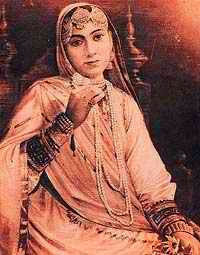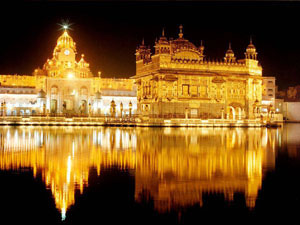Much feared was his blood line that it was sperated and exiled from India. Mahraja Daleep Singh was brought to England to stop any uprisings...
Wherever he went there was freedom of Religon. He restored and built many Churches, Mosques, Mandirs and Gurdwaras.
Maharaja Ranjit Singh Biography
- Reign:
- Coronation:
- Full name:
- Titles:
- Born:
- Birthplace:
- Died:
- Successor:
- Father:
- Mother:
- 12 April 1801 27 June 1839
- 12 April 1801
- Ranjit Singh
- Sher-e-Punjab (Lion of Punjab)
- Maharaja of Lahore
- Sarkar Khalsaji (Head of State)
- Napoleon of East
- Lord of Five Rivers
- 13 November 1780
- Gujranwala
- 20 June 1839
- Kharak Singh
- Mahan Singh
- Raj Kaur
Ranjit Singh belonged to a Sikh clan of Northern India. He was born in Gujranwala, now in modern-day Pakistan, according to some historians, into a Jatt Sikh family and some that he was born into a Sansi Sikh family who were Sukerchakia misldars. As a child he suffered from smallpox which resulted in the loss of one eye. At the time, much of Punjab was ruled by the Sikhs under a Confederate Sarbat Khalsa system, who had divided the territory among factions known as misls. Ranjit Singh's father Mahan Singh was the Commander of the Sukerchakia misl and controlled a territory in the west Punjab based around his headquarters at Gujranwala. After his father's death he was raised under the protection of Sada Kaur of the Kanheya Misl. Ranjit Singh succeeded his father at the age of 18. After several campaigns, he conquered the other misls and created the Sikh Empire.

The Maharaja
Ranjit Singh was crowned on 12 April 1801 (to coincide with Baisakhi). Sahib Singh Bedi, a descendant of Guru Nanak Dev, conducted the coronation. Gujranwala served as his capital from 1799. In 1802 he shifted his capital to Lahore. Ranjit Singh rose to power in a very short period, from a leader of a single Sikh misl to finally becoming the Maharaja (Emperor) of Punjab.
He then spent the following years fighting the Afghans, driving them out of the Punjab. He also captured Pashtun territory including Peshawar (now referred to as North West Frontier Province and the Tribal Areas). This was the first time that Peshawari Pashtuns were ruled by Punjabis. He captured the province of Multan which encompassed the southern parts of Punjab, Peshawar (1818), Jammu and Kashmir (1819). Thus Ranjit Singh put an end to more than a Hundred years of Muslim rule in Multan Area. He also conquered the hill states north of Anandpur Sahib, the largest of which was Kangra.
When the Foreign Minister of the Ranjit Singh's court, Fakir Azizuddin, met the British Governor-General of India, Lord Auckland, in Simla, Lord Auckland asked Fakir Azizuddin which of the Maharaja's eyes was missing, Azizuddin replied: "The Maharaja is like the sun and sun has only one eye. The splendor and luminosity of his single eye is so much that I have never dared to look at his other eye." The Governor General was so pleased with this reply that he gave his gold watch to Azizuddin.
Ranjit Singh's Empire was secular, none of the subjects were discriminated against on account of their religions. The Maharaja never forced Sikhism on his subjects.
Secular Sikh Rule

The empire of the Sikhs was most exceptional in that it allowed men from religions other than their own to rise to commanding positions of authority. Besides the Singh (Sikh), the Khan (Muslim) and the Misr (Hindu Brahmin) feature as prominent administrators. The Christians formed a part of the militia of the Sikhs. In 1831, Ranjit Singh deputed his mission to Simla to confer with the British Governor General, Lord William Bentinck. Sardar Hari Singh Nalwa, Fakir Aziz-ud-din and Diwan Moti Ram ― a Sikh, a Muslim and a Hindu representative ― were nominated at its head.
Wives of Ranjit Singh
Rani Mehtab Kaur of Town of Batala (Gurdaspur District) , Rani Raj kaur (d.1838) of Baherwal (Kasur District), Rani Rattan kaur and Rani Daya Kaur of Gujrat, Rani Chand kaur (d.1840) of Village Chainpur (Amritsar District), Rani Gulab Kaur (d.1838) of Village Jagdeo (Amritsar District), Rani Lachhmi Kaur of Vilage Jogki Khan (Gujranwala District), Rani Jind kaur (1817-1863) of Village Chachar (Gujranwala District), Rani Raj Banso Devi(d.1835)of Kangra Hill State.
The spire and ceilings of Kashi Vishwanath Temple (rebuilt in 1780) in Varanasi were plated with 820 Kilograms of Gold gifted by Ranjit Singh in 1839.
Externally, everyone in the Sikh empire looked alike; they supported a beard and covered their head, predominantly with a turban. This left visitors to the Punjab quite confused. Most foreigners arrived there after a passage through Hindustan, where religious and caste distinctions were very carefully observed. It was difficult for them to believe that though everyone in the Sarkar Khalsaji looked similar, they were not all Sikhs. The Sikhs were generally not known to force either those in their employ or the inhabitants of the country they ruled to convert to Sikhism. In fact, men of piety from all religions were equally respected by the Sikhs and their ruler. Hindu sadhus, yogis, saints and bairagis; Muslim faqirs and pirs; and Christian priests were all the recipients of Sikh largess. There was only one exception – the Sikhs viewed the Muslim clergy with suspicion. Mullahs were not looked upon kindly, as they were known to fan fanaticism.

In their conquests, the Sikhs never perpetrated atrocities as by invaders into the sub-continent. It was true that the Sikhs held a grudge against the Afghans for the atrocities they had perpetrated, over decades, against them. Before them, the Mughals had hunted down the Sikhs like animals in the field. Every Sikh carried a price on his head. The Afghans had caused havoc and mayhem in the Punjab during the lifetime of both Ranjit Singh's father and grandfather. Despite that, during the rule of the Sikhs there were no reports of torture of the kind routinely inflicted upon the Sikhs by some of the Muslim rulers of Hindustan and subsequently by the Afghan invaders. The Sikhs were reportedly a most tolerant nation.
The Sikhs were never accused of the routine inhuman behavior attributed to the Muslims. In fact, they made every attempt not to offend the prejudices of Muslims noted Baron von Hügel, the famous German traveler, yet the Sikhs were referred to as being harsh. In this regard, Masson's explanation is perhaps the most pertinent:
"Though compared to the Afghans, the Sikhs were mild and exerted a protecting influence, yet no advantages could compensate to their Mohaomedan subjects, the idea of subjection to infidels, and the prohibition to slay kine, and to repeat the azan, or summons to prayer".
Hinduism emphasizes the sanctity of cows, which has carried over into Sikhism. The ban on cow slaughter was universally imposed in the Sarkar Khalsaji.
The Sikhs never razed places of worship to the ground belonging to the enemy. The Sikhs were utilitarian in their approach. Marble plaques removed from Jahangir's tomb at Shahdera were used to embellish the Baradari inside the Fort of Lahore, while the mosques were left intact. Forts were destroyed however, these too were often rebuilt ― the best example being the Bala Hissar in Peshawar, which was destroyed by the Sikhs in 1823 and rebuilt by them in 1834.
Gurdwaras built by Maharaja Ranjit Singh

At the Harmandir Sahib, much of the present decorative gilding and marblework date back from the early 19th century. The gold and intricate marble work were conducted under the patronage of Maharaja Ranjit Singh, Maharaja of the Punjab. The Sher-e-Punjab (Lion of the Punjab) was a generous patron of the shrine and is remembered with much affection by the Sikhs. Maharaja Ranjit Singh deeply loved and admired the teachings of the Tenth Guru of Sikhism Guru Gobind Singh, thus he promoted the teachings of the Dasam Granth (the Tenth Granth) and built two of the most sacred temples in Sikhism. These are Takht Sri Patna Sahib, the birth place of Guru Gobind Singh, and Takht Sri Hazur Sahib, the place where Guru Gobind Singh took his final rest or mahasamadhi, in Nanded, Maharashtra in 1708.
Revered as "Sachkhand Sri Hazur Abchal Nagar Sahib", this historical shrine, which is one of the five Takhts (thrones) of the Sikhs is situated near Godavari river and was constructed by Maharaja Ranjit Singh ji at the site where Guru Gobind Singh ji breathed his last. It took 5 years to complete (1832-1837).
When Shere-E-Punjab Maharaja Ranjit Singh learnt that there is no big memorial at Nanded where Sarbans Dani, the Tenth Master Shri Guru Gobind Singh Ji had spent his last days, he deputed Chanda Singh to build a Grand Gurudwara. The Construction of Gurudwara Sachkhand Sri Hazur Sahib was undertaken at Nanded at this place from where Shri Guru Gobind Singh Ji had left for heavenly abode in 1708 A.D.
During the construction, acute shortag of water was felt. Meit Jathedar Baba Gahoo Singh Ji built this Holy Well through Kaar Seva some in around 1838 A.D. to meet the requirement. Traditionally every day one Gagar (Pitcher) is filled from river Godavari and another drawn from this holy well for giving bath to the Singhasan Sahib of Shri Guru Gobind Singh Ji in Sachkhand Shri Hazur Sahib.


